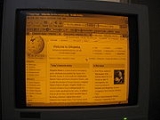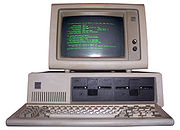
Monochrome monitor
Encyclopedia

Computer display
A monitor or display is an electronic visual display for computers. The monitor comprises the display device, circuitry, and an enclosure...
which was very common in the early days of computing, from the 1960s through the 1980s, before color monitors became popular. They are still widely used in applications such as computerized cash register systems. Green screen was the common name for a monochrome monitor using a green
Green
Green is a color, the perception of which is evoked by light having a spectrum dominated by energy with a wavelength of roughly 520–570 nanometres. In the subtractive color system, it is not a primary color, but is created out of a mixture of yellow and blue, or yellow and cyan; it is considered...
"P1" phosphor
Phosphor
A phosphor, most generally, is a substance that exhibits the phenomenon of luminescence. Somewhat confusingly, this includes both phosphorescent materials, which show a slow decay in brightness , and fluorescent materials, where the emission decay takes place over tens of nanoseconds...
screen.
Abundant in the early-to-mid-1980s, they succeeded Teletype
Teletype Corporation
The Teletype Corporation, a part of American Telephone and Telegraph Company's Western Electric manufacturing arm since 1930, came into being in 1928 when the Morkrum-Kleinschmidt Company changed its name to the name of its trademark equipment...
terminals
Computer terminal
A computer terminal is an electronic or electromechanical hardware device that is used for entering data into, and displaying data from, a computer or a computing system...
and preceded color CRTs as the predominant visual output device for computers.
Design
Unlike color monitors, which display text and graphics in multiple colors through the use of alternating-intensity red, green, and blue phosphorPhosphor
A phosphor, most generally, is a substance that exhibits the phenomenon of luminescence. Somewhat confusingly, this includes both phosphorescent materials, which show a slow decay in brightness , and fluorescent materials, where the emission decay takes place over tens of nanoseconds...
s, monochrome monitors have only one color of phosphor (mono means "one", and chrome means "color"). All text and graphics are displayed in that color. Some monitors have the ability to vary the brightness of individual pixels, thereby creating the illusion of depth and color, exactly like a black-and-white television.
Monochrome monitors are commonly available in three colors: if the P1 phosphor is used, the screen is green monochrome. If the P3 phosphor is used, the screen is amber monochrome. If the P4 phosphor is used, the screen is white monochrome (known as "page white"); this is the same phosphor as used in early television sets.
An amber screen was claimed to give improved ergonomics, specifically by reducing eye strain; this claim appears to have little scientific basis.
Uses
The most famous green screen product is arguably the original IBM PCIBM PC
The IBM Personal Computer, commonly known as the IBM PC, is the original version and progenitor of the IBM PC compatible hardware platform. It is IBM model number 5150, and was introduced on August 12, 1981...
monochrome display, designated the IBM 5151
IBM 5151
The IBM 5151 was 12" transistor–transistor logic monochrome monitor, shipped with the original IBM Personal Computer.It only produced green colors because it used P39 phosphor. IBM designed its MDA monochrome display system to deliver extremely well-formed characters for the time...
(the PC itself had the model number 5150). From the outset, the 5151 was designed to work with the PC's Monochrome Display Adapter (MDA)
Monochrome Display Adapter
The Monochrome Display Adapter introduced in 1981 was IBM's standard video display card and computer display standard for the PC. The MDA did not have any pixel-addressable graphics modes...
text-only graphics card, but soon the third-party Hercules Graphics Card
Hercules Graphics Card
The Hercules Graphics Card was a computer graphics controller made by Hercules Computer Technology, Inc. which, through its popularity, became a widely supported display standard. It was common on IBM PC compatibles connected to a monochrome monitor . It supported one high resolution text mode and...
became a popular companion to the 5151 screen because of the Hercules' high-resolution bitmap
Bitmap
In computer graphics, a bitmap or pixmap is a type of memory organization or image file format used to store digital images. The term bitmap comes from the computer programming terminology, meaning just a map of bits, a spatially mapped array of bits. Now, along with pixmap, it commonly refers to...
ped monochrome graphics capability, much used for business presentation graphics generated from spreadsheet
Spreadsheet
A spreadsheet is a computer application that simulates a paper accounting worksheet. It displays multiple cells usually in a two-dimensional matrix or grid consisting of rows and columns. Each cell contains alphanumeric text, numeric values or formulas...
s like Lotus 1-2-3
Lotus 1-2-3
Lotus 1-2-3 is a spreadsheet program from Lotus Software . It was the IBM PC's first "killer application"; its huge popularity in the mid-1980s contributed significantly to the success of the IBM PC in the corporate environment.-Beginnings:...
.
Clarity
Pixel for pixel, monochrome monitors produce sharper text and images than color CRTCathode ray tube
The cathode ray tube is a vacuum tube containing an electron gun and a fluorescent screen used to view images. It has a means to accelerate and deflect the electron beam onto the fluorescent screen to create the images. The image may represent electrical waveforms , pictures , radar targets and...
monitors. This is because each pixel on a monochrome monitor is made up of one phosphor dot, located in the center of the pixel; whereas on a color monitor, each pixel is made up of three phosphor dots (one red, one blue, one green), none of which are in the center of the pixel. Monochrome monitors were used in almost all dumb terminals and are still widely used in text-based applications such as computerized cash registers and point of sale
Point of sale
Point of sale or checkout is the location where a transaction occurs...
systems because of their superior sharpness and enhanced readability.
Some green screen displays were furnished with a particularly full/intense phosphor coating, making the characters very clear and sharply defined (thus easy to read), but generating a somewhat disturbing afterglow-effect (sometimes called a "ghost image") when the text scroll
Scroll
A scroll is a roll of parchment, papyrus, or paper, which has been drawn or written upon.Scroll may also refer to:*Scroll , the decoratively curved end of the pegbox of string instruments such as violins...
ed down the screen or when a screenful of information was quickly replaced with another as in word processing
Word processing
Word processing is the creation of documents using a word processor. It can also refer to advanced shorthand techniques, sometimes used in specialized contexts with a specially modified typewriter.-External links:...
page up/down operations. Other green screens avoided the heavy afterglow-effects, but at the cost of much more pixel
Pixel
In digital imaging, a pixel, or pel, is a single point in a raster image, or the smallest addressable screen element in a display device; it is the smallest unit of picture that can be represented or controlled....
ated character images. The 5151, amongst others, had brightness and contrast controls to allow the user to set their own compromise.
The ghosting effects of the now-obsolete green screens have become an eye-catching visual shorthand for computer-generated text, frequently (and ironically) in "futuristic" settings. The opening titles of the first Ghost in the Shell
Ghost in the Shell (film)
"See You Everyday" is different from the rest of the soundtrack, being a pop song sung in Cantonese by Fang Ka Wing. It can be faintly heard playing in the marketplace scene, when Batou is hunting the ghost-hacked puppet....
film and the Matrix source code of the Matrix trilogy science fiction film
Science fiction film
Science fiction film is a film genre that uses science fiction: speculative, science-based depictions of phenomena that are not necessarily accepted by mainstream science, such as extraterrestrial life forms, alien worlds, extrasensory perception, and time travel, often along with futuristic...
s prominently feature computer displays with ghosting green text. The XScreenSaver
XScreenSaver
XScreenSaver is a collection of about two hundred free screensavers for Unix and Mac OS X computers. It was created by Jamie Zawinski in 1992 and is still maintained by him....
package of screen savers by Jamie Zawinski
Jamie Zawinski
Jamie Zawinski , commonly known as jwz, is a former professional American computer programmer responsible for significant contributions to the free software projects Mozilla and XEmacs, and early versions of the Netscape Navigator web browser...
also includes a screen saver called Phosphor that prints green text with a simulated ghosting effect. Green text is also featured in the Swan's computer in Lost
Lost (TV series)
Lost is an American television series that originally aired on ABC from September 22, 2004 to May 23, 2010, consisting of six seasons. Lost is a drama series that follows the survivors of the crash of a commercial passenger jet flying between Sydney and Los Angeles, on a mysterious tropical island...
series.
Screen burn
Monochrome monitors are particularly susceptible to screen burn (hence the advent, and name, of the screen saver), because the phosphors used are very high intensity. Another effect of the high-intensity phosphors is an effect known as "ghosting", wherein a dim afterglow of the screen's contents is briefly visible after the screen has been blanked. This has a certain place in pop culture, as evidenced in movies such as The MatrixThe Matrix
The Matrix is a 1999 science fiction-action film written and directed by Larry and Andy Wachowski, starring Keanu Reeves, Laurence Fishburne, Carrie-Anne Moss, Joe Pantoliano, and Hugo Weaving...
.
This ghosting effect is deliberate on some monitors, known as "long persistence" monitors. These use the relatively long decay period of the phosphor glow to reduce flickering (and, therefore, eye-strain).

